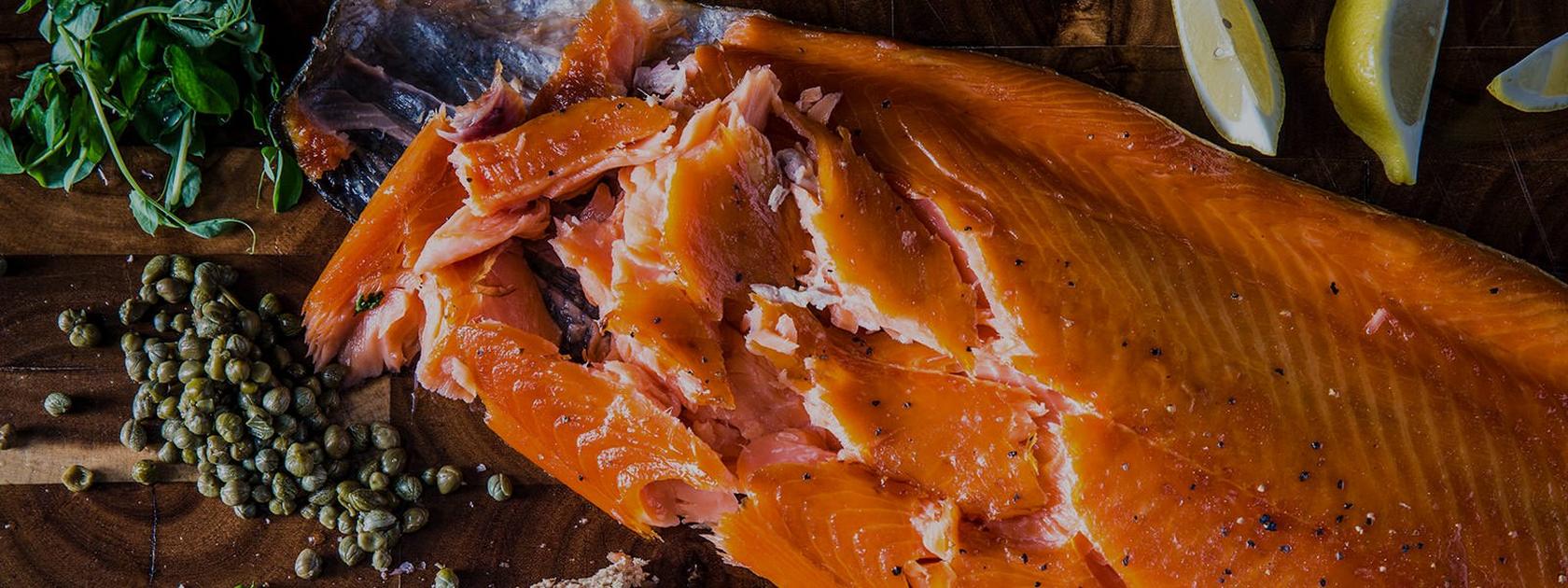
Smoking salmon is incredibly simple. You probably already have all of the supplies you need at home. All that's needed is time, and a fresh side of salmon with the skin still on.
Your supply list:
- Two baking sheets
- Plastic wrap
- Cans, tubs, or jugs to weigh down the salmon
- Brown sugar
- Salt
- Black pepper
- One large side of salmon
The video below walks you through the process.
We’ve rounded up this guide covering everything you need to know about how to smoke salmon -- from smoked salmon rub and the best wood for smoking salmon to salmon cooking times, internal cooking temperatures, nutritional information, and more.
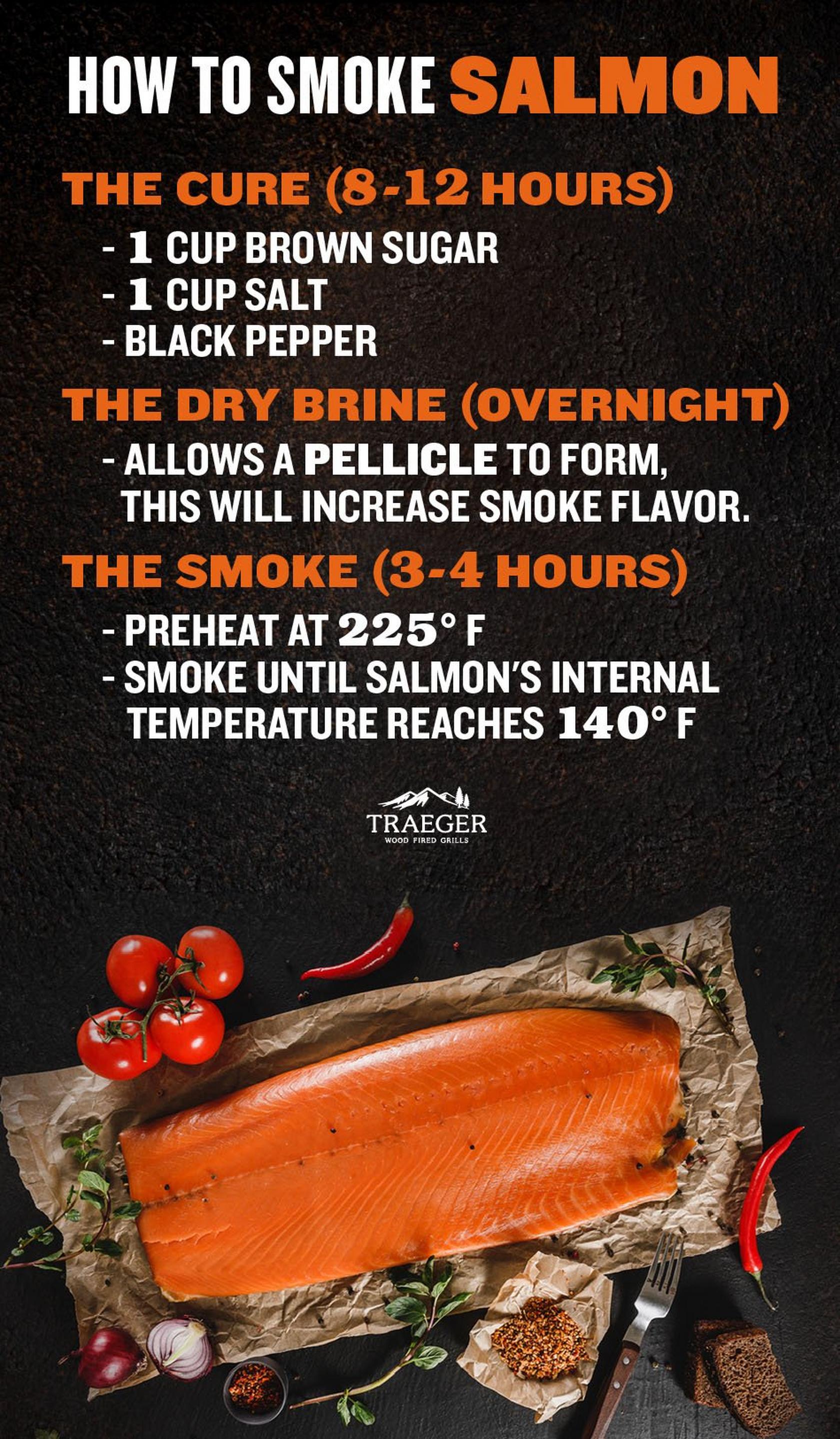
How To Prepare Smoked Salmon (Step-by-Step)
Our simple smoked salmon recipe takes all the guesswork out of cooking to ensure you get perfect smoked salmon every time with minimal effort.
Step 1: How to Cure Salmon
When most people talk about curing, they’re talking about a dry cure. You also have the option of using a wet cure which is the exact same thing as brine.
Brine or Wet Cure
With smoked salmon brine, you’ve got three basic elements to deploy: sugar, salt, and water. As mentioned above, the salt denatures proteins and removes excess moisture while simultaneously enhancing the fish’s ability to stay moist while cooking. Meanwhile, your sugar will boost preservation by inhibiting the growth of bacteria which enables your salmon to attract and hold the water being added by the wet cure.
You don’t have to stick with water. If you fancy adding an extra kick to your smoked salmon brine, try our recipes for vodka brined smoked wild salmon or our cider hot-smoked salmon.
Dry Cure
While wet curing your salmon lets you get creative with flavors, it’s sometimes considered less effective than dry curing in terms of preservation. It also takes a little bit longer -- which is why it makes sense to start with a basic dry cure when learning how to prepare smoked salmon.
A basic smoked salmon cure needs only three ingredients:
- 1 cup brown sugar
- 1 cup salt
- Black pepper
Simply combine the ingredients in a small bowl, lay a piece of plastic wrap on a flat surface enough to cover the whole salmon, and then spread half the mixture on top. Lay your salmon fillet side down on top of the mixture, top it with the other half (spreading evenly). Next, just fold up the edges, wrap the salmon tightly, and stick in the fridge for 8-12 hours.
You’ll want to leave your fillet in the fridge for this amount of time no matter how thick it is, and you should try to weigh down the fish. Placing heavy cans or bottles on top will normally do the trick, and although you’ve got some leeway in terms of how long you’re curing, don’t let your salmon sit for more than 48 hours. That’ll make your fish way too salty.
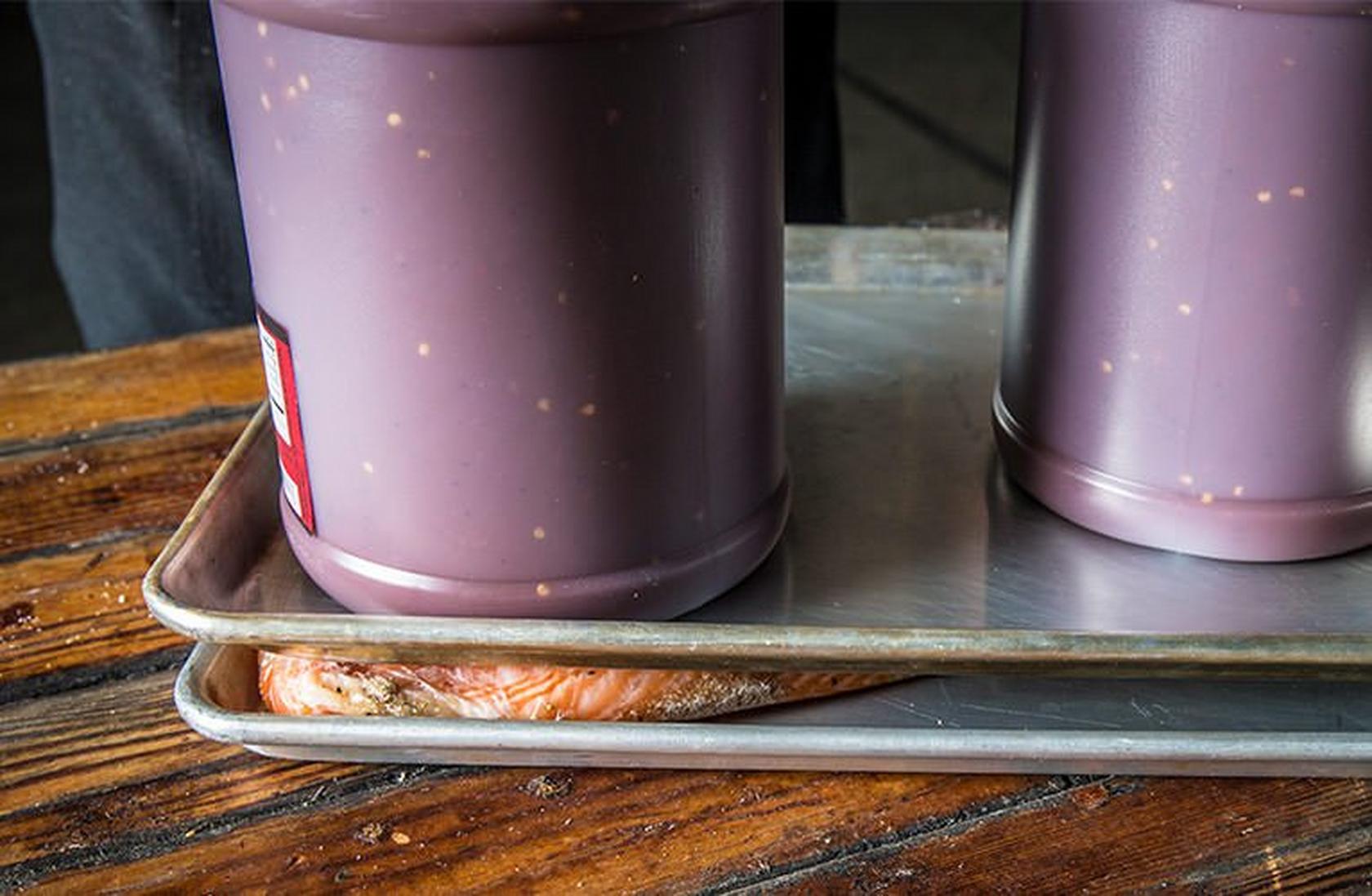
Step 2: Dry Brine Salmon
After curing in the fridge, it’s time to let your salmon dry out overnight. Drying allows a film called a pellicle to form on your fish which helps the smoke from your wood pellet grill adhere to the fillet more efficiently.
All you’ve got to do is completely rinse the dry cure mixture off your salmon and pat dry (this ensures your fish doesn’t end up tasting too salty). Next, dry your salmon flat on a cooling rack on top of a sheet pan, place it in the refrigerator, and allow it to sit overnight.
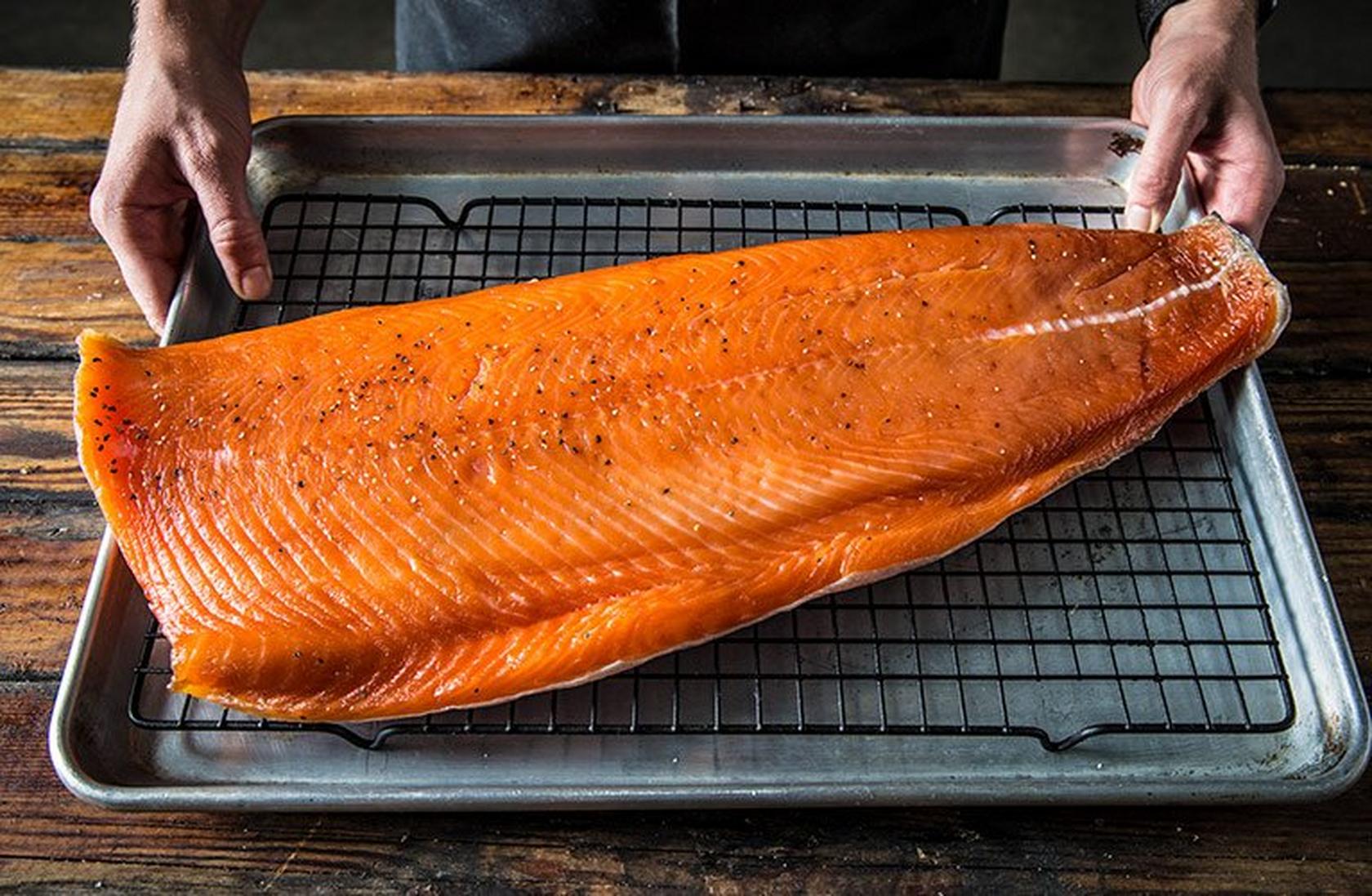
Step 3: How Long to Smoke Salmon
After your salmon is cured and dried, it’s time to hot smoke that fish. Our experts recommend that you smoke salmon for 3-4 hours, at 225 degrees Fahrenheit.
If you’re using a Traeger, getting to that temperature just means starting your grill and using your Smoke Setting. If you have a WiFIRE-enabled grill, you can also set to Super Smoke which is a lower temperature that will allow your fillet to soak up even more smoky flavors.
After setting to Smoke or Super Smoke, let your grill preheat with the lid closed for 5-10 minutes. Next, place your salmon directly on the grill grate (skin side down) and smoke for 3-4 hours or until your internal temperature reaches 145 degrees Fahrenheit.
From there, all that’s left to do is to remove the salmon from your grill, slice thin, and enjoy. It’s incredible served hot, chilled, or as part of a wide range of recipes (we’ll get to those pretty soon).
That’s really all there is to it.
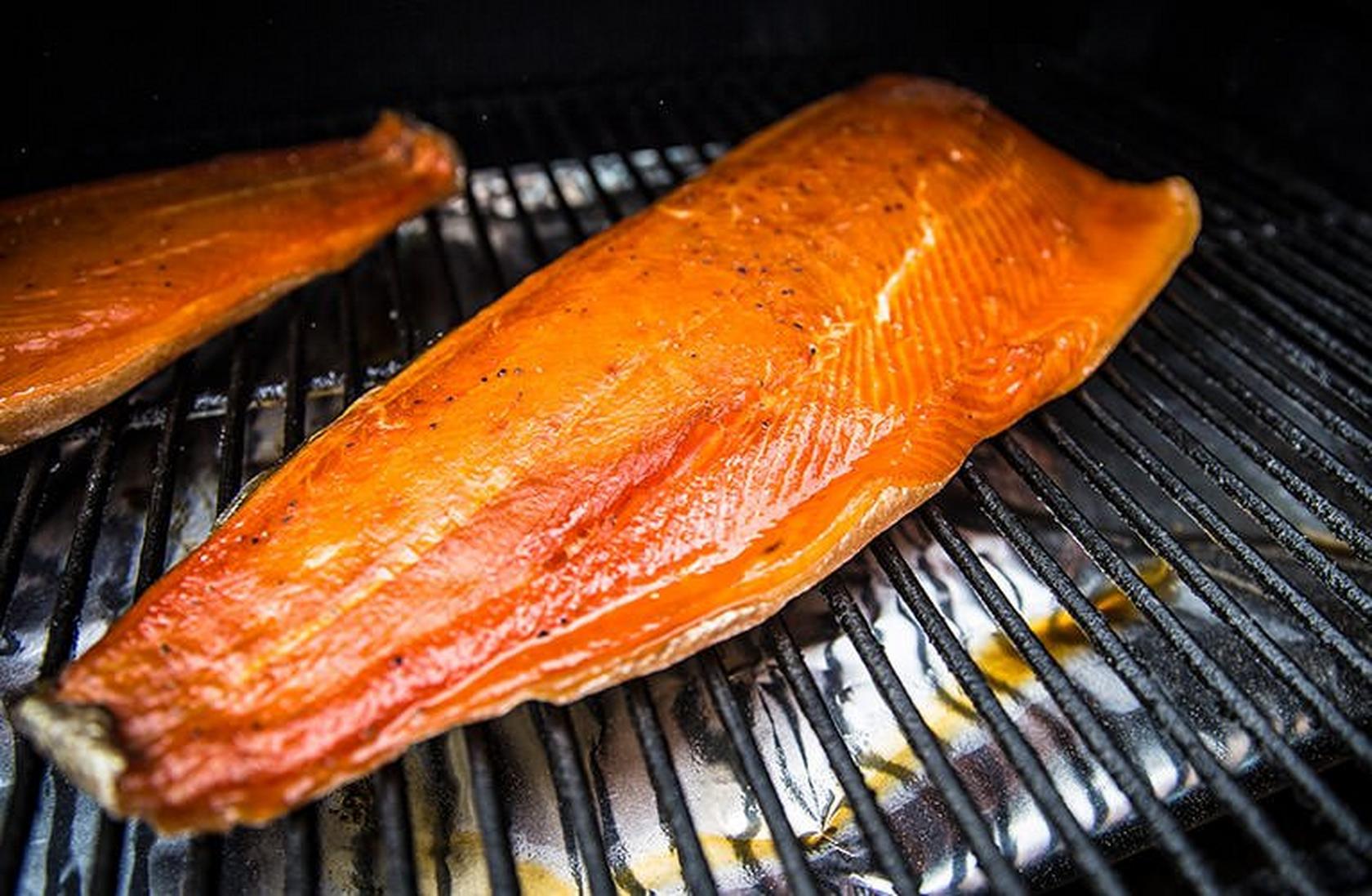
Why Should You Cure and Smoke Salmon?
Before we jump into smoked salmon recipes, let’s talk about why you should be smoking it in the first place.
A lot of the curing and smoking process is about preservation. Your ancestor’s ancestors came up with the idea to cure (or brine) fatty fish like salmon before refrigerators existed as a way to keep it from going bad. It all boils down to salt content because salt slows spoilage.
By curing your salmon with a salty rub or brine, you’ll draw out excess moisture and reduce your cut’s weight by around 15%. The flesh subsequently condenses which slows down bacteria and keeps your salmon fresh longer. Curing your salmon also gives it that gorgeous, reddish hue and glossy sheen that make everybody and their mom salivate.
But curing isn’t just about preservation and appearance. By removing extra moisture from your fish, you’ll also be setting your salmon up for the perfect smoke. Salting salmon will lift and intensify its bold, natural flavors alongside any other herbs or spices you decide to add to your cure or brine.
From there, smoking your salmon is always going to be the best option. The low and slow approach will complement the preservation job of your cure by locking in moisture and preventing all those juicy, natural flavors from escaping. Your salmon won’t dry out, and the taste you get from smoking your salmon on 100% all-natural hardwoods is second-to-none.
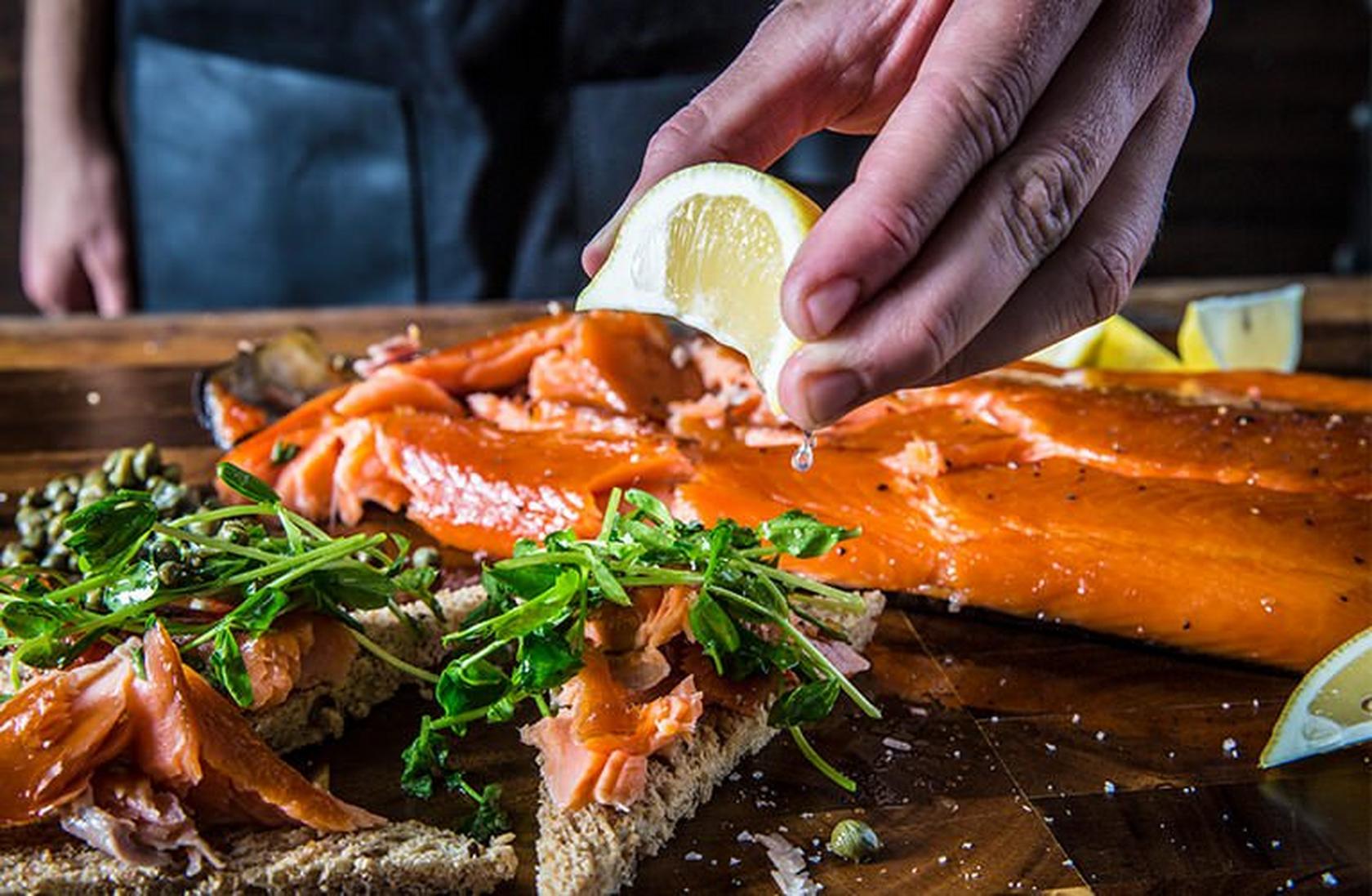
Methods of Smoking Salmon
It’s worth pointing out there are a couple of ways to smoke salmon. One option is to cold smoke. Cold smoked salmon is cured and then cooked on super low temperatures (normally under 80 degrees Fahrenheit). It’s the sort of stuff you normally find at the grocery store sliced paper-thin in vacuum-sealed packages. Cold smoked salmon doesn’t keep as long and isn’t quite as versatile, so for now we’re just going to help you focus on hot smoked salmon.
Hot smoking allows you to properly and simply cook huge cuts to perfection. After curing, hot smoked salmon cooks at temperatures of 180 degrees Fahrenheit or above which ensures you reach the FDA’s recommended internal temperature of 145 degrees Fahrenheit. Safety and taste factor aside, hot smoked salmon is a lot easier to incorporate into other recipes because it’s easier to reheat and keeps for longer.
So, that’s why you cure and hot smoke salmon and fortunately, the process is simple. With the temperature regulation and ease of a wood pellet grill, smoking salmon to perfection is easy.
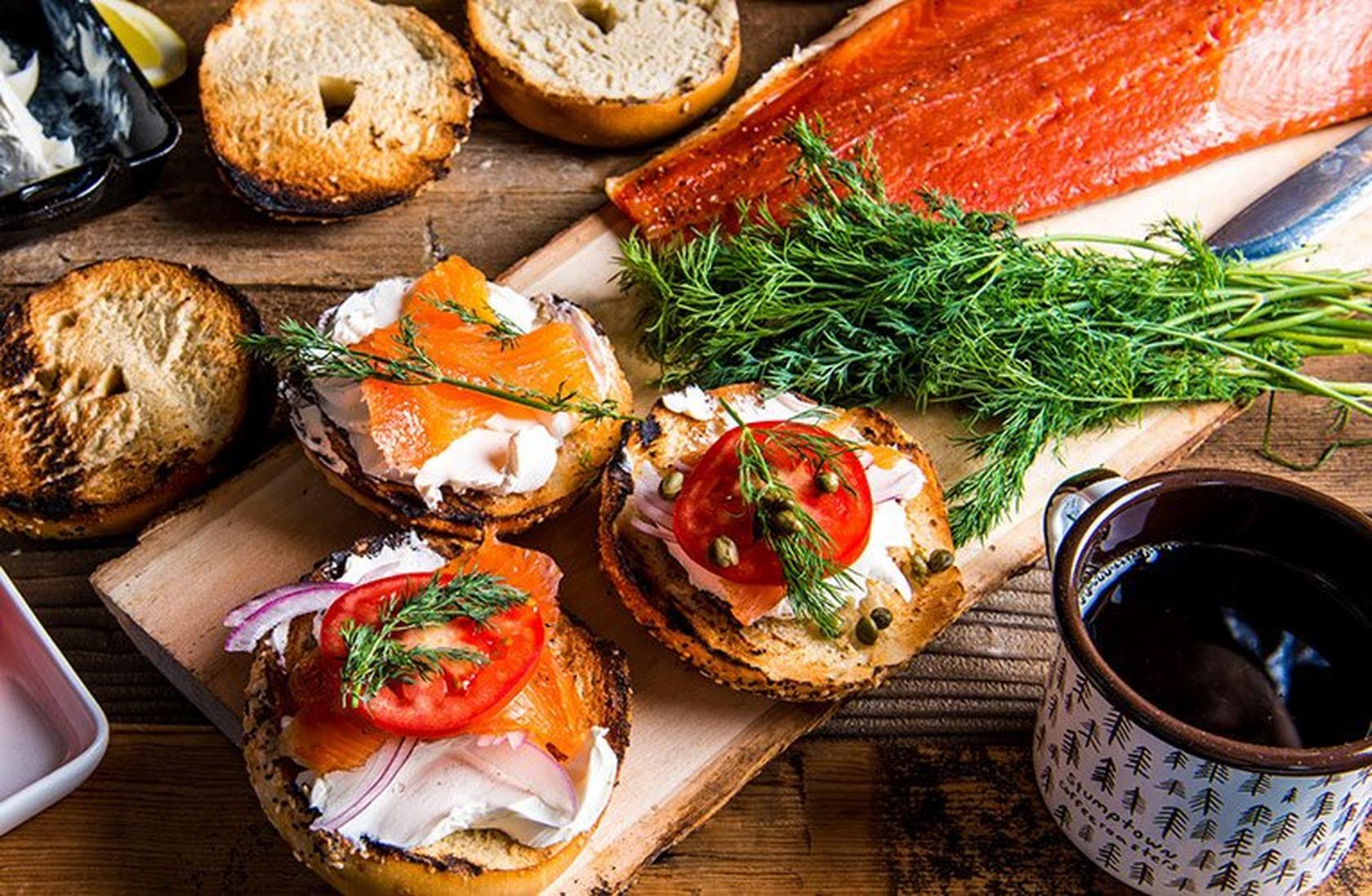
Best Wood for Smoking Salmon
We recommend Alder BBQ wood pellets as the best wood for smoking salmon. Alder offers a pure, clean flavor that perfectly complements the delicateness of flaky salmon.
Apple, Cherry, Pecan or even Maple do the job if you’re trying to add a bit of smoky sweetness to your fillet. Don’t be afraid to play around with flavors and test the waters! If you’re in the mood for something different, take a look at our Hardwood Guide for tips.
But remember, the quality of your smoked salmon will depend on the quality of fuel you’re using. Wood chips will give you plenty of smoke, but only the compact cell structure of hardwood pellets provide the right amount of moisture content to maintain a perfect burn-to-smoke ratio. With wood pellets, you’re getting a slow, reliable burn that produces show-stopping results every single time. Also, watch out for other non-Traeger branded hardwood pellets that contain too high a moisture ratio because this will create bitter-tasting white smoke instead of the pure, blue smoke you want.
Smoked Salmon on a Pellet Grill
It’s best to use an electric smoker if you can, to achieve a rich and flavorful smoked salmon fillet. The taste, simplicity, and consistency of cooking on a wood pellet grill means you’re able to plate up earth-shattering smoked salmon without having to fuss over the grill or stress about an uneven job.
Because pellets burn hotter and slower than chips, you get way more control over your electric grill's temperature via a steady flow of consistent, indirect heat -- not to mention a totally even smoke. That means no flare-ups, no uneven zones, and little ash or build-up.
If you’re equipped with a Traeger, smoking salmon is even simpler. Not only is your Smoke Setting the exact temperature required for a perfectly smoked salmon, but our digitally controlled convection heating system allows for easy temperature settings you can monitor on your phone.
Translation: With a Traeger, you won’t need to constantly check on your salmon.
The ingredients and preparation steps above are for smoking salmon on a pellet grill.
How to Smoke Salmon in the Oven
Believe it or not, it’s possible to properly hot smoke salmon in an oven -- but boy, it’s tricky.
The most common method of oven smoking salmon is to line a baking tray with foil, place your salmon onto a wire rack over the tray, and cover with foil. After that, you’ll stick on a medium heat, switch the heat off, and leave until your fillet hits that internal temp of 145 degrees.
Just be careful, because this route isn’t easy. Maintaining a consistent smoke at a low temperature is hard with an oven.
How to Serve Smoked Salmon
You don't have to serve smoked salmon as part of a recipe — it's a delicious appetizer or snack all on its own.
A classic way to serve smoked salmon is with thin crackers and cream cheese. The crackers give a little crunch to the bite, and the cream cheese a pleasant creamy texture to pair with the savory, salty fish. Our smoked bacon cheese ball might be a pairing to consider. You can also add elements like sliced onions, fresh herbs, or lemon wedges.
Place the crackers, cream cheese, and smoked salmon on a cutting board, and let your family or guests build the bites the way they like them.
Uses for Smoked Salmon
Smoked salmon isn’t just delicious, it’s healthy, too. It’s super high in those fatty omega-3 acids that promote heart health, filled with Vitamin B, and loaded with potassium. In terms of smoked salmon calories, the USDA estimates you’re looking at 117 calories per 100-gram serving.
Bottom line: Smoked salmon is pretty good for you, although because of the higher salt content, cured salmon is probably not something you want to eat every day.
When it comes to how you can use smoked salmon, the sky is basically the limit. It’s brilliant hot and fresh off your Traeger, but you can get creative with your leftovers.
If you love a savory breakfast, check out our recipe for smoked salt-cured lox or our smoked salmon potato bake, which makes for a hearty breakfast casserole that can feed large hordes in the morning.
For snacks or lunch, work leftovers into a light smoked salmon salad or hardwood smoked salmon spread that is amazing for lox or bagels. Looking for something a bit heavier? Try our recipe for wood-fired smoked salmon flatbread or salmon tacos.
Ok, you get the idea. You can do just about whatever you want with smoked salmon. So, if you need some inspiration, explore all our smoked salmon recipes, fire up, and start grilling. See other recipe ideas for your smoked salmon down below.
How Long Does Smoked Salmon Last?
When you’re buying cold smoked salmon from the grocery store, it typically stays fresh for about five days in the fridge after opening. But homemade, hot smoked salmon leftovers will normally last you a couple days longer so plan for up to seven days in the fridge. Just make sure to seal your leftovers tightly to lock in the moisture and aromas.
You can also freeze smoked salmon in an airtight bag, and it should retain its quality in the freezer for a few months (defrost it in the fridge overnight when planning to cook).
Smoked Salmon: A Fun And Simple Way To Get Started Smoking
If you're new to smoking, smoked salmon is a terrific way to start. You'll get a feel for the basics that go into just about every smoke — seasoning, curing, and the low and slow heating process.
You'll be amazed at how the natural wood smoke from your Traeger makes salmon so deep and flavorful — and you'll be ready to try an even bigger project next time.
And that’s it! We’ve covered how to hot smoke salmon, dry cure mixtures, the best wood for smoking, and everything in between. You’ve got this, fire up your Traeger, and get smoking.